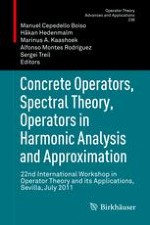2014 | Book
Concrete Operators, Spectral Theory, Operators in Harmonic Analysis and Approximation
22nd International Workshop in Operator Theory and its Applications, Sevilla, July 2011
Editors: Manuel Cepedello Boiso, Håkan Hedenmalm, Marinus A. Kaashoek, Alfonso Montes Rodríguez, Sergei Treil
Publisher: Springer Basel
Book Series : Operator Theory: Advances and Applications
